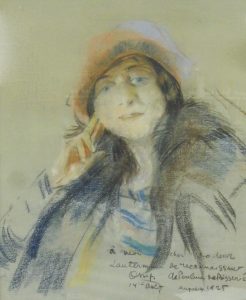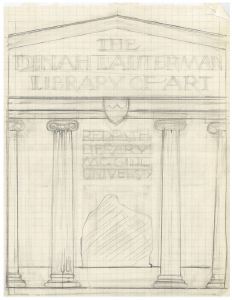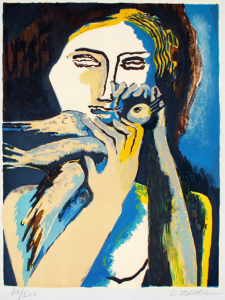A French version follows. Une version française suit.
By Jane O’Brien Davis, Museum Database Assistant, McGill Visual Arts Collection
What’s in a name? The Blackader-Lauterman Library of Art and Architecture is named after two people: Gordon Home Blackader and Dinah Lauterman. Portraits of both are part of the McGill Visual Arts Collection and are on display in the Blackader-Lauterman Library of Architecture and Art. Gordon Home Blackader (1885-1916), to whom we owe the first portion of the library’s name, was a graduate of McGill’s School of Architecture and former student of the École des Beaux-Arts de Paris. He is remembered as a partner in the highly successful architecture firm Barott, Blackader & Webster and lost his life while fighting as a captain in World War I. Dinah Lauterman, on the other hand, is an equally notable figure whose story is more scarcely known by the McGill community and general public. What better occasion than Women’s History month to delve into the fascinating portrait of this important artist and McGill benefactress?!
About the Portrait

Ossip Zadkine, Portrait of Dinah Lauterman (1925), Pastel on canvas, Visual Arts Collection, McGill University, Montreal, Quebec.
Portrait of Dinah Lauterman, dated 1925, is a pastel portrait created by French-Russian artist Ossip Zadkine (1890-1967) (Fig 1). Given that there is no record of Zadkine ever visiting Canada, one can suppose that the work was created in Paris, France, epicentre of knowledge, research and creativity during the 1920s and city in which the artist lived and worked for the majority of his career. In the bottom right-hand corner of the drawing, Zadkine included an inscription in French. It reads, “À mon cher Docteur Lauterman… [To my dear Dr. Lauterman]” Dr. Max Lauterman was a graduate of the 1895 class of McGill’s Faculty of Medicine, an avid art critic, and the much older brother of Dinah Lauterman.[1] It is quite possible that the artist created the artwork, which is outside of his preferred medium of sculpture, as a gift or commission for his presumed friend Dr. Max Lauterman.
About the Subject
Dinah Lauterman (1899-1945) was a Canadian visual artist based in Montreal.[2] She initially studied at the Art Association of Montreal, alongside artists such as landscape painter and founding member of the Canadian Group of Painters Randolph Hewton (1888-1960).[3] She later continued her education at the École des beaux-arts de Montréal, now part of the Université du Québec à Montréal’s Faculty of Arts, under renowned artists such as Edwin Holgate (1892-1977) and Albert Laliberté (1878-1953).[4] Although her initial artistic training was in drawing and watercolour, Lauterman eventually started to experiment with sculpture, which became her medium of choice.[5] As her reputation started to grow, she exhibited her works in galleries, including at the art gallery of the Art Association of Montreal, where she became an associate in 1929. One of her acclaimed sculptural works, entitled Bust of an Indian Chief Caughnawaga(1930), is currently on display at the Montreal Museum of Fine Arts.
About the Artist
Ossip Zadkine (1890-1967) was a Russian-born French sculptor. He studied briefly at the École des Beaux-Arts de Paris, before dropping out to pursue his art independently. As he rejected the constraints of academic art, he started to identify more with the avant-garde art movement.[6] Zadkine spent most of his life in France, except during WWII when he fled persecution in Europe and spent time living and working in New York.[7] Like Lauterman, he initially studied and practiced watercolour, drawing, and gouache before transitioning to sculpture. He was well-recognized for his cubist three-dimensional representations of the human form.[8] Over the years, his style became more romantic and expressive. Zadkine is known for sculpting elongated figures with simplistic features, always putting emphasis on the hands of his subjects.[9] Many believe these hands to function as the artist’s signature in many of his sculptures and other artworks.[10]
Portrait of Dinah Lauterman is one of Zadkine’s earlier works and is more representational than his other pastel drawings. Zadkine’s interest in cubism, bold colors, fragmented forms, and geometric shapes is visible within his other pastel works (Fig. 2). However, we do not see this with his Lauterman portrait. Zadkine’s expressive style is seen within the likeness of Dinah Lauterman. The short and thick lines used to define her form suggest this portrait was done briskly, capturing the sitter’s casual but engaged pose. Unsurprisingly, the artist has paid considerable attention to Lauterman’s hand, on which she rests her cheek. The lines and colors of her characteristically elongated fingers become more refined in this area. Her hand position has two fingers pointing towards her face, which is the most defined feature of the portrait. The directing hand position guides the viewer’s eye towards the face, creating a focal centre for the work. The definition of her face and hands, due to the artist’s fine line work, is underscored by more expressive details of the portrait. Surrounding the focal centre of the image is the hat and jacket of the sitter, which employed the flat long side of a pastel crayon.
From the inscription on the art work, we can surmise that is was either a gift or commission for or by Dr. Max Lauterman. Perhaps for this reason, it does not represent the more abstracted cubist style that Zadkine would eventually become widely known for. It does, however, demonstrate his early training, the significance of hand gestures in his work, and his sensitivity to line and color. The inscription and medium of this artwork also draws a connection between Zadkine and Lauterman. This is a portrait by an artist of an artist, allowing the connection between these two artists to be visualized.
Lauterman’s Legacy at McGill

R.W. Klinck, Dinah Lauterman Library of Art (1947), Pencil on paper, McGill University Rare Books and Archives, Montreal, Quebec.
Following Dinah Lauterman’s premature death in 1945, Annie Lauterman bequeathed a library endowment in memory of her late sister.[11] This endowment included a new special collection of fine art and art historical books, which were originally proposed by Lauterman to stand independently as the “Dinah Lauterman Library of Art” (Fig. 3).[12] In 1947, to honour Dinah Lauterman and in celebration of the endowment, McGill held an exhibit of many of Lauterman’s works. This exhibit included Lauterman’s 1929 plaster cast sculpture Silence, which is in McGill’s Visual Arts Collection.[13] The endowment was welcomed as a means of filling gaps in McGill’s collection,[14] and has allowed Dinah Lauterman’s legacy to live on through the continued art and art historical education provided by McGill through the Blackader-Lauterman Collection.
[1] “From the ‘Daily’ Files.” The McGill Daily., vol. 10 , no. 82, (27 January 1921), p. 3
[2] “Canadian Women Artists History Initiative.” Canadian Women Artists History Initiative : Artist Database : Artists : Lauterman, Dinah, 2007. http://cwahi.concordia.ca/sources/artists/displayArtist.php?ID_artist=4957.
[3] ibid
[4] “Canadian Women Artists History Initiative.” Canadian Women Artists History Initiative : Artist Database : Artists : Lauterman, Dinah, 2007. http://cwahi.concordia.ca/sources/artists/displayArtist.php?ID_artist=4957.
[5] ibid
[6] “Ossip Zadkine.” Encyclopædia Britannica. Encyclopædia Britannica, inc., November 21, 2019. https://www.britannica.com/biography/Ossip-Zadkine.
[7] Zadkine, Ossip, and Abraham Marie Hammacher. Zadkine. New York: Universe Books, 1959, p. 1-7.
[8] The Editors of Encyclopaedia Britannica. “Ossip Zadkine.” Encyclopædia Britannica. Encyclopædia Britannica, inc., November 21, 2019. https://www.britannica.com/biography/Ossip-Zadkine.
[9] Zadkine, Ossip, and Abraham Marie Hammacher. Zadkine. New York: Universe Books, 1959.
[10] ibid
[11]Lauterman, Dinah, Library of Art, 1946, Container 0432, File 07826, Donation, Endowments, and Bequests, McGill University Rare Books and Archives McGill University Libraries.
[12] Ibid
[13]Natanblut, Joel, and Severson, Sarah. The Dark Room, June 23, 2014. https://blogs.library.mcgill.ca/digitization/category/rbsc/blackader-lauterman-collection/.
[14]Lauterman, Dinah, Library of Art, 1946, Container 0432, File 07826, Donation, Endowments, and Bequests, McGill University Rare Books and Archives McGill University Libraries.
_______________________________________________________
Le portrait de Dinah Lauterman

Ossip Zadkine, Portrait of Dinah Lauterman (1925), Pastel on canvas, Visual Arts Collection, McGill University, Montreal, Quebec.
Que se cache-t-il derrière un nom? La bibliothèque d’art et d’architecture Blackader-Lauterman honore deux personnes importantes dans l’histoire de McGill: Gordon Home Blackader et Dinah Lauterman. Un portrait de chacun de ses individus fait partie de la Collection d’arts visuels (CAV) de l’Université. Ceux-ci sont exposés dans la salle d’étude du lieu en question. Gordon Home Blackader (1885-1916), à qui la bibliothèque doit la première partie de son nom, était un diplômé de l’École d’architecture de McGill et un ancien élève de l’École des Beaux-Arts de Paris. Partenaire du prospère cabinet d’architecture Barott, Blackader & Webster, il a perdu la vie au combat pendant la Première Guerre mondiale. Dinah Lauterman, quant à elle, est une figure tout aussi notable dont l’histoire est moins connue au sein de communauté mcgilloise. Mars étant le Mois de l’histoire des femmes, j’ai cru bon profiter de l’occasion pour explorer le fascinant portrait de cette artiste et bienfaitrice de l’Université McGill.
À propos du portrait
Le portrait de Dinah Lauterman, daté de 1925, est un dessin au pastel réalisé par l’artiste franco-russe Ossip Zadkine (1890-1967) (Fig 1). Ce dernier n’ayant en l’apparence jamais mis les pieds au Canada, on peut supposer que l’œuvre a été créée à Paris, épicentre du savoir, de la recherche et de la créativité dans les années 1920 et ville dans laquelle l’artiste a vécu et travaillé pendant la majeure partie de sa carrière. Dans le coin inférieur droit du dessin, Zadkine a inclus une inscription en français. On peut y lire: « À mon cher Docteur Lauterman… » Le Dr Max Lauterman était un diplômé de la promotion 1895 de la Faculté de médecine de McGill, un critique d’art et le frère aîné de Dinah Lauterman. Il est fort possible que l’œuvre d’art, qui est en dehors du médium de choix de l’artiste, ait été réalisée en cadeau ou en réponse à une commande du Dr Max Lauterman.
À propos du sujet
Dinah Lauterman (1899-1945) était une artiste visuelle canadienne basée à Montréal. Elle a d’abord étudié à la Art Association of Montreal aux côtés d’artistes tels Randolph Hewton (1888-1960), peintre paysagiste et membre fondateur du Canadian Group of Painters. Elle a ensuite poursuivi son éducation à l’École des beaux-arts de Montréal, faisant désormais partie de l’École des arts visuels et médiatiques de l’Université du Québec à Montréal (UQAM), sous la direction d’artistes de renom tels Edwin Holgate (1892-1977) et Albert Laliberté (1878-1953). Malgré une formation artistique spécialisée dans le dessin et l’aquarelle, Lauterman s’est éventuellement tournée vers la sculpture. Alors que sa carrière prenait de l’essor, ses œuvres ont été exposées bon nombre de galeries, notamment à la galerie d’art de la Art Association of Montreal, où elle devint associée en 1929. L’une des sculptures de Lauterman, intitulée Bust of an Indian Chief Caughnawaga (1930), fait partie de la collection du Musée des beaux-arts de Montréal.
À propos de l’artiste
Ossip Zadkine (1890-1967) était un sculpteur français d’origine russe. Ayant brièvement étudié à l’École des Beaux-Arts de Paris, il a rapidement décroché pour poursuivre son art de manière indépendante. Rejetant les contraintes de l’art académique, il s’identifiait davantage aux mouvements artistiques d’avant-garde. Zadkine a passé la majeure partie de sa vie en France, sauf pendant la Seconde Guerre mondiale où il a fui la persécution en Europe en s’installant temporairement à New York. Comme Lauterman, il a d’abord étudié et pratiqué l’aquarelle, le dessin et la gouache avant de passer à la sculpture. Il était bien connu pour ses représentations cubistes et trois dimensionnelles de la forme humaine. Au fil des ans, son style est devenu plus romantique et expressif. Zadkine est reconnu pour ses figures allongées, ses traits simplistes, et l’accent mis sur les mains de ses sujets – ces dernières agissant en quelque sorte comme une seconde signature de l’artiste.
Le portrait de Dinah Lauterman est l’une des premières œuvres de Zadkine et est beaucoup plus figurative comparativement à ses autres dessins au pastel qui témoignent davantage de son intérêt pour le cubisme, les couleurs vives, les formes fragmentées et la géométrie (Fig.2). Cela dit, le style expressif de Zadkine est bien présent dans l’image de Dinah Lauterman. Les lignes courtes et épaisses utilisées pour définir ses traits indiquent que le portrait a été réalisé rapidement, capturant la pose décontractée mais engagée du sujet. Fidèle à lui-même, l’artiste a accordé une attention considérable à la main de Lauterman, sur laquelle repose sa joue. Les traits et les couleurs de ses doigts allongés sont raffinés. La position de la main, dont deux doigts pointent vers le visage, constitue l’aspect le plus définit du portrait et guide l’œil de l’observateur vers le visage, créant ainsi un point focal au sein de l’image. Autour de ce point focal se trouvent le chapeau et la veste de la gardienne, dessinés avec le côté plat du crayon pastel.
D’après l’inscription sur l’œuvre d’art, nous pouvons supposer nous pouvons supposer que le portrait était un cadeau ou une commande pour ou par le Dr Max Lauterman. C’est d’ailleurs probablement ce contexte qui explique l’absence du style cubiste et plus abstrait pour lequel Zadkine est reconnu. Le Portrait de Dinah Lauterman démontre toutefois la formation académique de l’artiste, l’importance des gestes des mains dans son travail et sa sensibilité aux lignes et aux couleurs. L’inscription et le médium de l’œuvre d’art établissent également un lien entre Zadkine et Lauterman. Il s’agit du portrait dessiné d’une artiste du dessin devenue sculptrice, par un artiste sculpteur.
L’héritage de Lauterman à McGill

R.W. Klinck, Dinah Lauterman Library of Art (1947), Pencil on paper, McGill University Rare Books and Archives, Montreal, Quebec.
Après la mort prématurée de Dinah Lauterman en 1945, Annie Lauterman a légué une dotation de bibliothèque à la mémoire de sa défunte sœur. Cette dotation comprenait une nouvelle collection spéciale de livres sur les beaux-arts et l’histoire de l’art (Fig 3). En 1947, en l’honneur de Dinah Lauterman et pour célébrer la dotation, McGill a organisé une exposition de plusieurs œuvres de Lauterman. Cette exposition comprenait une sculpture de plâtre réalisée par Lauterman en 1929 intitulée Silence. Cette dernière fait aujourd’hui partie de la Collection d’art visuel de McGill. La dotation a été accueillie comme un moyen de combler les lacunes de la collection de McGill et a permis à l’héritage de Dinah Lauterman de perdurer grâce à la formation continue en art et en histoire de l’art fournie par McGill par le biais de la Collection Blackader-Lauterman.















Leave a Reply
You must be logged in to post a comment.